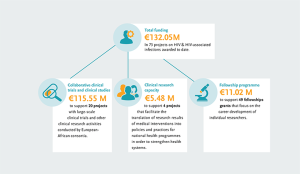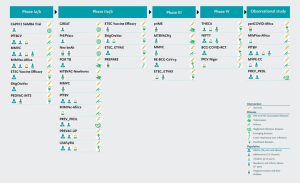World AIDS Day 2022: funding to end inequality
On 1 December EDCTP joins partners to commemorate World AIDS Day 2022 under the theme “Equalize”. Inequalities in HIV/AIDS prevention and care are holding back progress in ending AIDS. Therefore, EDCTP has dedicated a significant part of its funding to reducing inequalities in research on HIV/AIDS, often focusing on vulnerable populations who are at greater risk of HIV infection and AIDS-related deaths.
“As we aspire to turn the HIV epidemic around with the development of effective new products and tools and innovative implementation strategies, special attention is needed for priority populations, such as infants, children, and pregnant and lactating women, and to all those who face stigma, discrimination, marginalisation, criminalisation, and other barriers to access to care.”
Dr Michael Makanga, EDCTP Executive Director
By the end of 2021, there were an estimated 38.4 million people living with HIV, two thirds of whom are in the WHO African Region. There is no cure for HIV infection. However, with increasing access to effective HIV prevention, diagnosis, treatment and care, including for opportunistic infections, HIV infection has become a manageable chronic health condition, enabling people living with HIV to lead long and healthy lives.
EDCTP-supported research on HIV/AIDS focuses primarily on trials of innovative biomedical HIV prevention tools, strategies to reduce antiretroviral drug resistance, and research to ensure that products will reach and be used by populations with the greatest need. Understanding biological susceptibility and pathogenesis remains paramount. Other priorities include treatment optimisation for adults, children, adolescents, and pregnant women; improved diagnostics; and strategies to address the sexual and reproductive health needs of women living with and at risk of HIV.
Leave no child behind
In this article, we zoom in on children and adolescents, who consistently lag far behind the new proposed global 95–95–95 targets set by UNAIDS: that by 2030, 95% of people living with HIV, know their HIV status, 95% of people who know their status are receiving treatment and 95% of people on HIV treatment have a suppressed viral load so their immune system remains strong and the likelihood of their infection being passed on is greatly reduced.
WHO recommends a renewed focus on populations that have been left behind in the global response to HIV and AIDS. Only 52% of children living with HIV are on life-saving treatment. If we can show progress in ending new infections among children and ensuring all are on quality antiretrovirals (ARVs), we have greater hope and can ensure greater political commitment to end AIDS in all populations by 2030.
“An important question to address is how to effectively diagnose and treat young infants as well as newborns infected with HIV, with a special focus on interventions suitable for primary healthcare. Conducting research with these vulnerable populations is challenging, especially when working within the boundaries of health systems in sub-Saharan Africa. However, clinical research under field conditions generates critical scientific evidence to drive policy changes. This is where we also need to invest our efforts. ”
Dr Ilesh Jani, Instituto Nacional de Saúde (INS), Mozambique
EDCTP funds a number of projects that specifically address the challenges seen in children and adolescents. For example, there is a paramount need for paediatric formulations that are heat stable, available as fixed-dose combinations and appropriate formulations. The CHAPAS-4 and UNIVERSAL studies aim to improve first- and second-line treatment options for children living with HIV.
Adolescents have their own needs that must be addressed so they are managed effectively and can transition into their adult lives as seamlessly and healthy as possible. The BREATHER Plus project is evaluating the safety, efficacy and acceptability of alternative treatment regimens, including weekends-off therapy and long-acting injectables in children and adolescents. VITALITY investigates if vitamin D and calcium supplementation improves bone density and muscle function in adolescents living with HIV. The CHAPS project evaluates the use of pre- and post-exposure prophylaxis for the prevention of HIV in adolescents.
Mother-to-child-transmission (MTCT) continues to be the main cause of new childhood infections. The PROMISE-EPI project aims to address this via an innovative rescue intervention as part of immunisation programmes. The LIFE Study, on the other hand, focuses on early infant diagnosis and the uptake of ART and infant prophylaxis. A different approach is taken by PedMAb and Neo bnAb projects studying the administration of broadly neutralising monoclonal antibodies in HIV-exposed uninfected neonates and infants.
Finally, 6-monthly viral load (VL) monitoring is a key strategy to improve viral suppression, but this is often not achieved in children and adolescents. One of the barriers is centralised VL monitoring. The EAPoC-VL project is evaluating the use of point-of-care viral load monitoring to improve viral load suppression among children and adolescents living with HIV.


